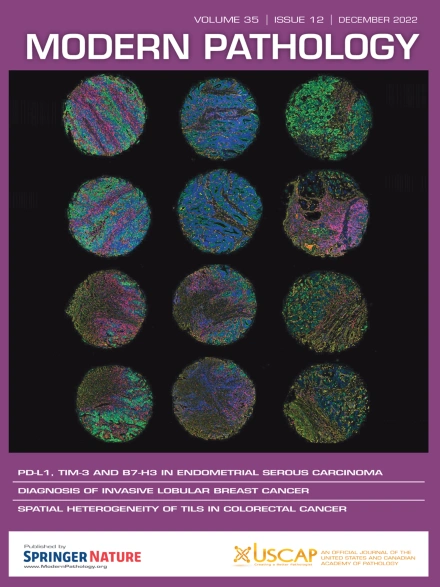Cytoplasmic p53 Immunostaining in Salivary Duct Carcinoma: A Poor Prognostic Factor Associated With Characteristic TP53 Variants
IF 7.1
1区 医学
Q1 PATHOLOGY
引用次数: 0
Abstract
Salivary duct carcinoma (SDC) is an uncommon, high-grade malignancy. Identifying suitable prognostic factors is crucial for developing effective treatment strategies for SDC. p53 Immunohistochemistry (IHC) is a potential prognostic marker for SDC. Traditionally, only the nuclear expression has been considered when evaluating aberrant p53 IHC patterns. However, recent studies on other organ cancers have highlighted the significance of the cytoplasmic p53 expression. We aimed to investigate the prognostic implications of cytoplasmic p53 positivity and its association with TP53 variants in a large cohort of patients with SDC. p53 IHC was performed in 327 patients with SDC who had undergone primary curative resection. Based on the immunostaining patterns, patients were classified into 4 groups: wild-type (WT), overexpression (OE), complete absence (CA), and cytoplasmic (CY). Additionally, the TP53 gene status was analyzed in 239 cases by Sanger and/or next-generation sequencing. The p53 IHC patterns of 327 cases were as follows: WT (n = 125; 38.2%), OE (n = 100; 30.6%), CA (n = 75; 22.9%), and CY (n = 27; 8.3%). A TP53 genetic analysis of 239 cases revealed the following: WT status (n = 80; 33.5%), missense/inframe variants (n = 86; 36.0%), and truncating variants (n = 73; 30.5%). Notably, 24 of the 25 CY cases (96%) harbored TP53 variants, which were predominantly located in the domains responsible for nuclear translocation. Of these, 22 exhibited truncating variants. In a multivariate analysis, CY cases demonstrated significantly shorter disease-free survival (DFS) than WT cases (P = .01). Furthermore, patients with aberrant p53 expression patterns (OE+CA+CY) had significantly worse DFS and overall survival than those with WT (P = .003 and .002, respectively). The presence of TP53 variants was also associated with poorer DFS and overall survival (P = .003 and .02, respectively). Our findings suggest that the cytoplasmic expression of p53 in SDC represents a distinct aberrant pattern underlying characteristic genetic abnormalities and has significant prognostic implications.
涎腺导管癌的细胞质p53免疫染色:与特征性TP53变异相关的不良预后因素
涎腺导管癌是一种罕见的高级别恶性肿瘤。确定合适的预后因素对于制定有效的SDC治疗策略至关重要。p53免疫组化(IHC)是SDC的潜在预后标志物。传统上,在评估异常p53 IHC模式时,只考虑核表达。然而,最近在其他器官肿瘤的研究已经强调了细胞质中p53表达的重要性。我们的目的是在一大批SDC患者中研究细胞质p53阳性及其与TP53变异的关系对预后的影响。我们对327例原发性根治性切除的SDC患者进行了p53免疫组化。根据免疫染色模式将患者分为野生型(WT)、过表达型(OE)、完全缺失型(CA)和细胞质型(CY) 4组。此外,通过Sanger和/或下一代测序分析239例患者的TP53基因状态。327例p53免疫组化模式如下:WT (n = 125;38.2%), OE (n = 100;30.6%), CA (n = 75;22.9%), CY (n = 27;8.3%)。239例TP53基因分析显示:WT状态(n = 80;33.5%),错义/帧内变异(n = 86;36.0%),截断变量(n = 73;30.5%)。值得注意的是,25例CY病例中有24例(96%)携带TP53变异,其主要位于负责核易位的结构域。其中22个表现出截断变异。在一项多变量分析中,CY病例的无病生存期(DFS)明显短于WT病例(P = 0.01)。此外,异常p53表达模式(OE+CA+CY)患者的DFS和总生存率明显低于WT患者(P分别为0.003和0.002)。TP53变异的存在也与较差的DFS和总生存率相关(P分别为0.003和0.02)。我们的研究结果表明,p53的细胞质表达在SDC中代表了一种独特的异常模式,潜在的特征性遗传异常,并具有重要的预后意义。
本文章由计算机程序翻译,如有差异,请以英文原文为准。
求助全文
约1分钟内获得全文
求助全文
来源期刊

Modern Pathology
医学-病理学
CiteScore
14.30
自引率
2.70%
发文量
174
审稿时长
18 days
期刊介绍:
Modern Pathology, an international journal under the ownership of The United States & Canadian Academy of Pathology (USCAP), serves as an authoritative platform for publishing top-tier clinical and translational research studies in pathology.
Original manuscripts are the primary focus of Modern Pathology, complemented by impactful editorials, reviews, and practice guidelines covering all facets of precision diagnostics in human pathology. The journal's scope includes advancements in molecular diagnostics and genomic classifications of diseases, breakthroughs in immune-oncology, computational science, applied bioinformatics, and digital pathology.
 求助内容:
求助内容: 应助结果提醒方式:
应助结果提醒方式:


